Join More Than 50,000+ Subscribers and get latest camera news and rumors
NEW CAMERA VIDEOS ON YOUTUBE
|
By admin, on April 16th, 2025
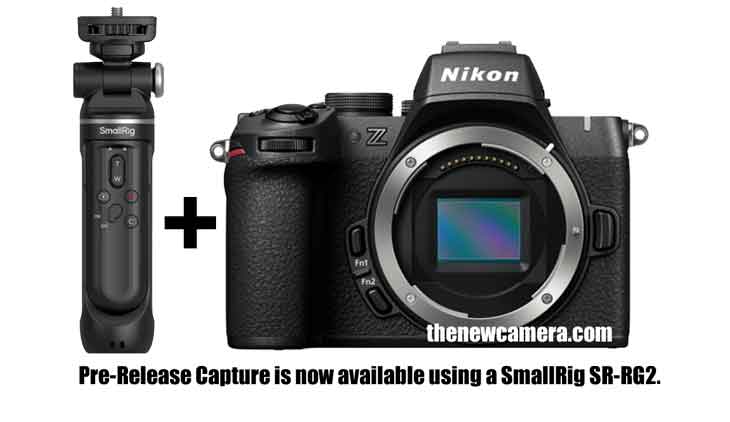
We all know that the Nikon Z50 II does have pre-release capture mode, but it doesn’t work well when you use the remote shutter of the Small Rig SR-RG2 Grip. Now with the latest update, Nikon now fixed the issue, and it will work in High Speed Frame Capture + Mode when paired with the SmallRig SR-RG2 Grip
Nikon Z50 II Firmware Update – Changes from “C” Firmware Version 1.00 to 1.01
- • Pre-Release Capture is now available using a SmallRig SR-RG2.
- • Added “русский” (Russian) to [Language] in [SETUP MENU] for Z50II cameras sold in the Middle East region.
- • Renamed d13 [Display on during burst] in [CUSTOM SETTINGS MENU].
- • Fixed the following issues.
- – In rare cases, the camera would stop responding when the camera was reconnected to SnapBridge after it was connected to Nikon Imaging Cloud while connecting to SnapBridge.
- – In synchronized release, pressing the shutter-release button of the master camera halfway initiated autofocus on the remote camera with the following setting selected.
- ▸ [CUSTOM SETTINGS MENU] > a6 [AF activation] > [AF-ON only]
Click here to download the update.
Follow us on our social pages FACEBOOK | TWITTER | INSTAGRAMto get live Camera News +Nikon Rumors 24X7
By admin, on April 16th, 2025
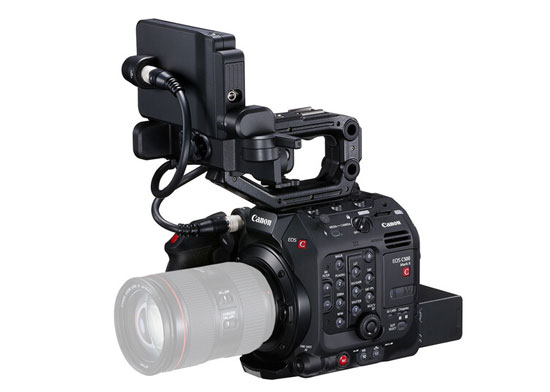
Canon C500 – The Canon cinema camera has a usable firmware update this time – Take a look at the list of improvements, if ur an owner and feel it’s important to have it, then only apply the updates
- Enables the digital tele-converter icon display on [Main Recording Displays] of [DISP Level 2].
- It adds the ability to apply a full-screen display to an external display according to the OSD output setting when using [Peripheral Border Display].
- Adds the [Motion Vector For Digital IS] menu option. Default [Disable]*.
*[Disable]: Prevents a phenomenon that may cause the image to shake along with the subject when recording a subject (such as a person or an animal) with a large amount of movement.
- Fixes minor issues.
- Fixes an issue in which aspect markers and other markers are not displayed correctly if the resolution of the video output configuration is set to [4192x3140 (4:3)] or [3768x3140 (6:5)] and the anamorphic desqueeze is applied.
Click here to download Canon C500 update

Sony A1 II, A1, and A9 III – Sony released a new firmware that includes minor bug fixes and a little bit of performance improvement. If you find them useful, then you can update it; otherwise, it isn’t a major performance-enhancing update
A1II Benefits and Improvements – Click here to download
- Fixes an issue where setting Recording Media to Sort Recording may cause a restart during still image capture
- Fixes an issue where the effectiveness of the Soft Skin Effect when recording movies in S-Log3 was not properly adjusted
A9III Benefits and Improvements – Click here to download
- Fixes an issue where setting Recording Media to Sort Recording may cause a restart during still image capture
- Fixes an issue where the effectiveness of the Soft Skin Effect when recording movies in S-Log3 was not properly adjusted
A1 Benefits and Improvements – Click here to download
- Fixes an issue where setting Recording Media to Sort Recording may cause a restart during still image capture
- Fixes an issue where the button registered with Recall Custom Hold may not be accepted
Follow us on our social pages FACEBOOK | TWITTER | INSTAGRAM to get live Camera News +
By admin, on April 15th, 2025
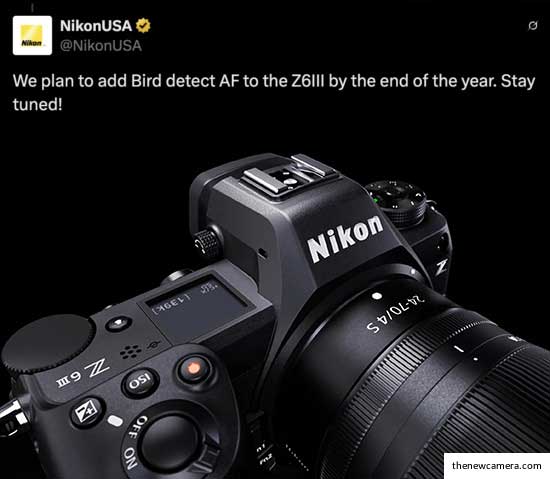
Today Nikon confirmed that bird eye autofocus mode is coming to the Nikon Z6 Mark III camera later this year in their social media post, that’s really great news since cameras like Nikon Z50 II, Z5II and Nikon Zf, which come at a lower price point than the Nikon Z6 III, now have bird eye autofocus mode. And Z6 III users are waiting for a long time to have it.
And we had reported back in November 2024 that Nikon is working on Z6 Mark 3 bird eye autofocus mode and they will roll it out as they are ready for it, and now we got the final confirmation from Nikon itself.
Best Lenses for Nikon Z6 III
Follow us on our social pages FACEBOOK | TWITTER | INSTAGRAMto get live Camera News +Nikon Rumors 24X7
By admin, on April 15th, 2025

Nikon Z5 II vs Sony A7 III – Let’s compare the two and find out the best, we have selected all the major difference between the two camera, starting from the desing part, and the the Major differences in the photography part of both camera,s and finally, the best camera for video.
In the Latest Nikon Z5 II, we have a deep rear hand grip and an enhanced display as well as an electronic viewfinder. The rear display screen in the Nikon Z5 II is a vari-angle display screen with higher resolution, so you can also create content/vlog with the camera, and photographers will have a bit more compositional freedom. The electronic viewfinder is of higher resolution and rated up to 3000 nits of brightness, helping to shoot perfectly in daylight conditions. The Nikon Z5 II design is slightly more professional and looks very similar to the Nikon professional Z6 III model. The battery life of the Nikon Z5 II is slightly limited so you have to carry an extra battery pack or a power bank with you.
| Aspect |
Nikon Z5 II |
Sony A7 III |
| Body Dimensions |
134 x 100.5 x 72 mm (Large handgrip) |
127 x 96 x 74 mm (Slightly small) |
| Weight |
700g (with battery, media) |
650g (with battery) |
| Grip & Ergonomics |
Larger, deeper grip with still/video switch, tactile dials |
Smaller grip, more custom buttons, compact layout |
| Build & Weather Sealing |
Magnesium alloy, weather-sealed (32 to 104°F, 85% humidity) |
Magnesium alloy, dust/moisture resistant (tropicalization) |
| Card Slots |
Dual UHS-II SD/SDHC/SDXC slots |
One UHS-II + one UHS-I SD slot |
| Display Size |
3.2-inch touchscreen |
3.0-inch touchscreen |
| Display Resolution |
2,100,000 dots |
921,600 dots |
| Display Type |
3-way tilting (up/down/side) vari-angle |
2-way tilting (up/down) |
| Touchscreen Functionality |
Full control (menus, focus, zoom) |
Limited (focus point, double-tap zoom) |
| Viewfinder Type |
Electronic OLED |
Electronic OLED |
| Viewfinder Resolution |
3,690,000 dots |
2,359,296 dots |
| Viewfinder Magnification |
0.8x |
0.78x |
| Viewfinder Eye Point |
21 mm |
23 mm |
| Battery |
1x EN-EL15c Lithium-Ion (~380 shots CIPA) |
1x NP-FZ100 Lithium-Ion (~610 shots CIPA) |
| Power Delivery |
USB-C input/output (live power during shooting) |
USB 3.1 (charging only) |
| Video I/O |
Micro-HDMI output |
Mini-HDMI output |
| Audio I/O |
3.5mm headphone, 3.5mm microphone |
3.5mm headphone, 3.5mm microphone |
| Other I/O |
3.5mm remote, USB-C 3.2/3.1 Gen 1 (data/power) and Multi-interface shoe |
Multi-interface shoe (remote/audio), USB 3.1 (data) |
| Wireless Connectivity |
2.4/5 GHz Wi-Fi 5 (802.11ac), Bluetooth 5.0 |
2.4 GHz Wi-Fi (802.11b/g/n), Bluetooth 4.1 |
| NFC |
None |
Included |
| Mobile App |
SnapBridge (Android/iOS, files/firmware/remote) |
Imaging Edge Mobile (Android/iOS, files/remote) |
| GPS |
Via smartphone (SnapBridge) |
Via smartphone (Imaging Edge) |

Internal Core specification of the camera
Both cameras use a 24-megapixel full-frame BSI CMOS sensor, but the Nikon Z5 II, with the help of new image processor features, has a standard ISO range of up to 64000 and expandable up to 204800, which is one stop more than that of the Sony A7 III.
Not only does it have a better ISO range, but the new Z5 II camera also uses a sensor-shift image stabilisation system of 7.5 stops. As we know, the A7 III is limited to 5 stops, so Z5 II will be helping you a bit more to capture low-light images while hand-holding this camera.
Adding more value to it, the autofocus sensitivity now can touch down to minus 10 EV, and in Sony, it is limited to minus 3. So, we consider all these factors — the Z5 II becomes a bit more suitable a camera to work with under variable light conditions.
Nikon Z5 II vs Sony A7 III – Photography Core Specs Comparison
| Aspect |
Nikon Z5 II |
Sony A7 III |
| Sensor Type |
24.5MP full-frame CMOS (6048 x 4032) |
24.2MP full-frame BSI CMOS |
| Sensor Crop |
1.0x (full-frame) |
1.0x (full-frame) |
| Image Stabilization |
5-axis sensor-shift IBIS(7.5 Stops CIPA) |
5-axis sensor-shift IBIS (5.0 stops CIPA) |
| ISO Sensitivity (Photo) |
100-64,000 (Extended: 50-204,800) |
100-51,200 (Extended: 50-102,400) |
| Autofocus Points |
273 phase-detection points |
693 phase-detection + 425 contrast points (93% coverage) |
| AI AF Type |
9 Different types of subject tracking include Bird eye AF |
Precise and better, but doesn’t have a dedicated bird eye AF mode |
| Autofocus Sensitivity |
-10 to +19 EV |
-3 to +20 EV |
| AF Modes |
Continuous-Servo, Full-Time Servo, Manual, Single-Servo |
Continuous, Manual, Single, Tracking |
| Specialized AF |
Bird/insect/vehicle + 9-subject AI detection |
Real-time Eye AF (human/animal) |
| Continuous Shooting |
14 FPS + 30 fps (Mech + electronic shutter) |
10 fps (mechanical/electronic) |
| Buffer Depth |
200 RAW frames @ 14 FPS |
~89 RAW at 10 fps |
| Shutter Type |
Mechanical focal plane + electronic rolling |
Mechanical + electronic front-curtain |
| Shutter Speed |
1/8000 to 30 sec, Bulb/Time modes |
1/8000 to 30 sec, Bulb mode |
| Metering Methods |
Center-Weighted, Highlight Weighted, Matrix, Spot |
Center-Weighted, Multi-zone, Spot |
| Metering Range |
-4 to 17 EV |
-3 to 20 EV |
| Exposure Modes |
Aperture Priority, Auto, Manual, Program, Shutter Priority |
Aperture Priority, Auto, Manual, Program, Shutter Priority |
| Exposure Compensation |
-5 to +5 EV (1/3, 1/2 EV steps) |
-5 to +5 EV (1/3, 1/2 EV steps) |
| White Balance |
Auto, Cloudy, Color Temp, Sunlight, Flash, Fluorescent, Incandescent, Manual, Shade |
Auto, Cloudy, Color Temp, Custom, Daylight, Flash, Fluorescent, Incandescent, Shade, Underwater |
| Image File Formats |
HEIF, JPEG, RAW (14-bit) |
JPEG, RAW (14-bit) |
| Aspect Ratios |
1:1, 3:2, 16:9 |
3:2, 16:9 |
| Interval Recording |
Yes |
No |
| Self-Timer |
2/5/10/20 sec delay |
2/5/10 sec delay |
| Flash Sync Speed |
1/200 sec |
1/250 sec |
| Flash Compensation |
-3 to +1 EV (1/3, 1/2 EV steps) |
-3 to +3 EV (1/3, 1/2 EV steps) |

Autofocusing mode
The new Z5 II features the same AI AF algorithm that we have seen in the Nikon Z8 camera and uses 9 different types of subject detection algorithms. While shooting a scene, it automatically detects a subject, focuses on their eye, and keeps tracking them.
So overall, the autofocusing experience of the Nikon Z5 II camera has been upskilled like a professional Nikon mirrorless camera.
The Sony A7 III does have a very strong eye autofocus and tracking mechanism, but it does lack a multiple subject detection mode or AI AF in it since it’s a 2018 model. Expecting too much from it isn’t good. Although it has a higher number of autofocus points, it does focus very well.
Continuous shooting speed:
The Nikon Z5 II camera is now able to capture 14 frames of RAW with the help of a mechanical shutter and up to 30 frames of full-size JPEG images. The camera also supports a pre-capture function, highly suitable for sports and wildlife shooters, that stores 30 30-FPS bursts before you press the shutter.
And the good thing is that the Nikon Z5 II refreshes its AI autofocus and auto exposure in every single frame, even if you are using it at 30 per second.
The Nikon Z5 II is also a highly reliable camera, but it remains limited to 11 frames per second. The Z5 II now becomes a perfect option for sports or wildlife photographers, anyone who loves to capture as many frames as possible of their favourite moment.
Nikon Z5 II vs Sony A7 III -Video Core Specs Comparison
| Aspect |
Nikon Z5 II |
Sony A7 III |
| Internal Recording Modes |
4K (3840 x 2160) at 23.98/25/29.97/50/59.94 fps; 1080p at 23.98/25/29.97/50/59.94/100/120 fps |
4K (3840 x 2160) at 23.98/25/29.97 fps; 1080p at 23.98/25/29.97/50/59.94/120 fps |
| Sensor Crop (4K) |
DX crop at 4k 60p |
NA |
| Internal Recording |
12-bit NRAW Video, 4:2:2 10-bit internal recording, 4K up to 29.97 fps |
8-bit via HDMI, 4K up to 29.97 fps |
| Video Profiles |
H.265, H.264/MOV/MP4 (N Log ) |
H.264, S-Log2/3, HLG |
| Recording Limit |
2 hr 5 min |
~29 min (pre-firmware) |
| Audio Recording |
24-bit 48 kHz (MOV/RAW), 16-bit 48 kHz (MP4) |
16-bit 48 kHz |
| Built-In Microphone |
Stereo |
Stereo |
| Fast/Slow-Motion Support |
None (1080p/120 fps max) |
None (1080p/120 fps max) |
| Streaming |
Yes / Upto 4K |
None |
Video comparison
In video, it’s very clearly visible in the table also that the Sony A7 III camera remains limited to 8-bit internal recording and even it has a time limitation of 30 minutes, whereas in the Nikon Z5 II camera we can record 4:2:2 10-bit internal recording at the rate of 4K 60 frames per second. But while recording at 60 FPS, we have to face DX crop, and when we are recording 4K 30 FPS, we are getting high-quality oversampled footage from the sensor.
Not limited to that, with higher quality video recording capability, you also get more stable footage due to the new 7.5 stops of IBIS mechanism, as well as integrated EIS compared to 4.5 to 5 stops of IBIS of the Sony A7 III.
Conclusions
Overall, for wedding cinematographers, content creators or professional cinematographers, the Nikon Z5 II is more usable in terms of specs when compared to the Sony A7 III.
Now, considering all these major factors, for sure, for a photographer, the Nikon Z5 II camera is now more suitable to use in comparison to the Sony A7 III camera. If Sony wants to beat the Z5 II. Sony needs to bring a perfect replacement for the A7 III camera. Either they should bring out the A7 IIIA or they should lower the price of A7 IV to an extent that users can buy it instead of the Nikon Z5 II.
Nikon Z5 II vs Nikon Z6 II | Nikon Z5 II vs Canon R8 | Nikon Z5 II vs Nikon Zf | Nikon Z5 II vs Sony A7 III
Get the Nikon Z5 II camera from B&H Store | Adorama.com | Amazon.com
Support us – Use or affiliate link Amazon.com | B&H Store | Adorama.com for the next purchase u make – it helps us 🙂
Follow us on our social pages FACEBOOK | TWITTER | INSTAGRAM to get live Camera News + Nikon Rumors 24X7
By admin, on April 15th, 2025
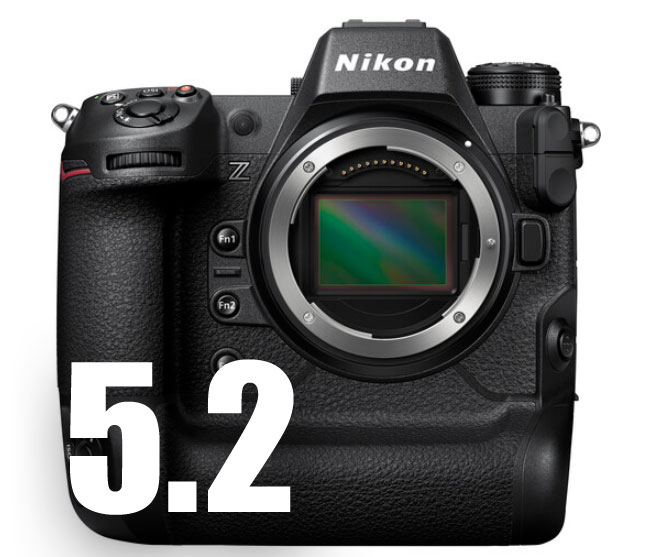
Nikon Z9 Firmware 5.2 Released in China and japan, and I hope and expect it will become available to other countries soon. Take a look at the details of the update
Translated version of the same
- • Now supports the “NX Field”* function, a remote photography system for businesses.
- * For an overview of NX Field and instructions on how to use NX Field, please visit the NPS website.
- NPS (Nikon Professional Services) website (English)
- *The smart device app “NX Field” is not available in some countries and regions.
- • The following bugs have been fixed:
- – In rare cases, when pressing the playback button after repeatedly shooting continuous shots, not all images would be displayed correctly.
- – In M mode, when taking continuous shots after changing the exposure, the exposure would occasionally be incorrect.
- – When a camera with the following settings is used as a linked release remote camera, the AF on the remote camera will be activated when the master camera’s shutter is pressed halfway.
- ▸ [Customization Menu] > a6 [Half-press AF lens activation] set to [Off]
[Custom Setting Menu]>a6 [Half-Press Shutter Drive AF]> [AF-ON Button Only]

What Is Nikon NX Field?
For those who don’t know about NX Field, the Nikon NX Field is a professional-grade remote shooting app from Nikon currently available for iOS apps for iPhones and iPads, first launched in June 2021, designed for agencies and pros to cover any event or game with multiple cameras flawlessly
- Control up to 10 cameras (one master, nine remotes) via wired LAN, wireless LAN, or 4G/5G networks.
- Adjust settings remotely, from autofocus to exposure, using the NX Field app on a smartphone or tablet (iPhone 8 or later, iPad Pro 2018+).
- Transfer images instantly to FTP servers for rapid publishing—crucial for newsrooms and sports agencies.
- Sync shutters for multi-angle shots, perfect for capturing that game-winning goal from every perspective.
Added support for enterprise users’ “NX Field” remote shooting system. Take a look at the features of the NX field software that you can do with your app
- Realizing shutter release, setting changes, and FTP image transmission of up to 10 remote cameras synchronized with a master camera via wired LAN cable.
- Wired LAN connection ensures reliable remote camera shutter release even in situations where many photographers are shooting with remote cameras via radio waves at once.
- Synchronization is also compatible with Wi-Fi connection using WT-5/6 Wireless Transmitters.
- The status of remote cameras, including connection status, latest shutter-release time, etc., can be confirmed from a master camera in order to avoid unintended errors.
- A smart device with the NX Field application installed can be used to change settings and check live view images of remote cameras, allowing for operation in narrow spaces or remote shooting from a distant location.
- Automatic FTP image transmission during synchronized shooting of a master and remote cameras as well as while changing camera settings via a smart device with the NX Field application.
- Easy recovery from FTP server network errors by remotely reconnecting to the server.
- Easy switching between shooting with a master camera only, with remote cameras only, or with both the master and remote cameras, which helps to avoid capturing unnecessary images and ensures that only the desired images are transferred.
- Autofocusing is possible with remote cameras from a master camera or smart device with the NX Field application.
- Remote shooting via the Internet, such as 4G/5G mobile network, is possible.
- The robotics of Mark Roberts Motion Control Limited can also be synchronized with a master camera.
- Silent remote shooting with compatible Z series cameras* for expanded shooting scenarios.
The content is updated on April 15, 2025
Follow us on our social pages FACEBOOK | TWITTER | INSTAGRAM to get live Camera News + Nikon Rumors 24X7
source Nikon Japan www.maging.nikon.com/imaging/lineup/software/nx_field/
By admin, on April 13th, 2025
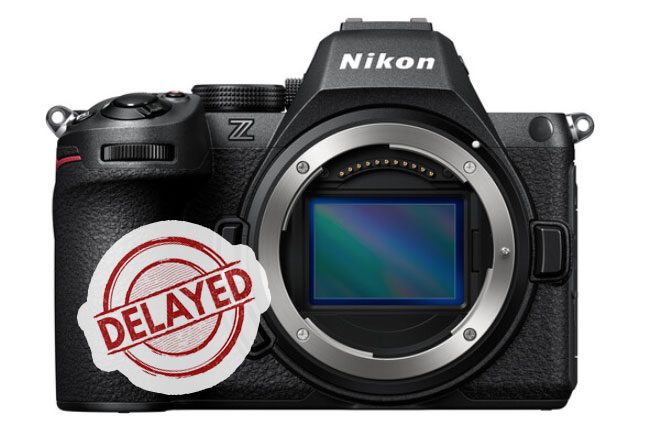
Nikon Z5 II is in very high demand. Japanese online stores that are taking pre-orders for the camera have already mentioned that they are getting an excessive number of pre-orders than they expected.
We are currently receiving many more orders for this product than we anticipated, so it may take some time for your order to be delivered. Thank you for your understanding.
In US the camera is expected to start shipping from April 24, 2025. Get the Nikon Z5 II camera from B&H Store | Adorama.com | Amazon.com
We have already done several comparison reviews of the Nikon Z5 II camera, you can check them out here.
Nikon Z5 II vs Nikon Zf
Nikon Z5 II vs Canon R8
Nikon Z5 II vs Nikon Z6 II
As I write this article, Nikon has not received any official statement regarding the shortage of supply of the Nikon Z5 II camera, but I think they will once they face the huge demand after April 24. Retailers will deliver on a first-come, first-served basis.
Follow us on our social pages FACEBOOK | TWITTER | INSTAGRAM to get live Camera News + Nikon Rumors 24X7
source nij.nikon.com
By admin, on April 11th, 2025
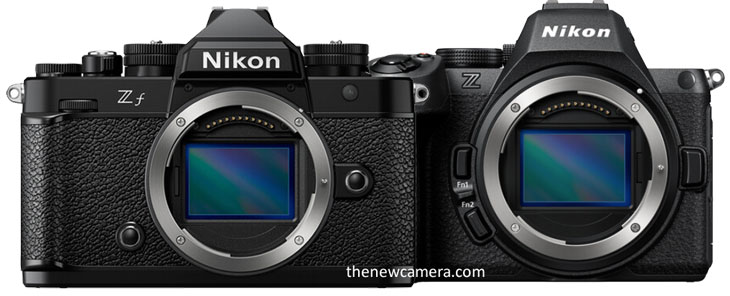
Nikon Z5 II vs Nikon Zf – Let’s compare the two and find out the major difference between the photography and the videography parts.
Photography Analysis
Nikon Zf camera features extensive manual control
First, let’s talk about the design of both cameras. Nikon Zf is built like a tank and features extensive manual control over the body with a retro look, so if you are someone who loves to have a retro-looking camera for photography purposes, without having a second thought in your brain, you should pick this camera.
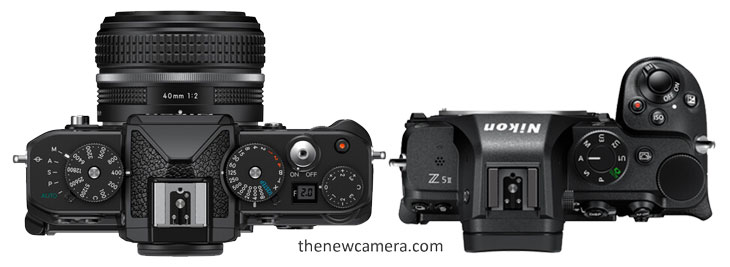
You have to buy an additional hand grip for Zf
In terms of overall design, the Nikon Z5 II camera has a deep hand grip, which is comfortable to hold for a longer period. However, due to its classic retro design, Zf does not have a deep or handy grip, so we have to buy it from SmallRig or a new addition, and you have to purchase it when you buy the Zf camera. In the Nikon Zf camera, we have a microSD card option and a UHS-II SD memory card slot, so you do have a dual card slot option—one is microSD. These cameras have similar 3.69 million-dot electronic viewfinders, but the Nikon Z5 II specifically mentions its brightness, which is 3000 nits—good for daylight shooting. The rest of the core specifications, which include the ports and the battery life, are approximately the same.
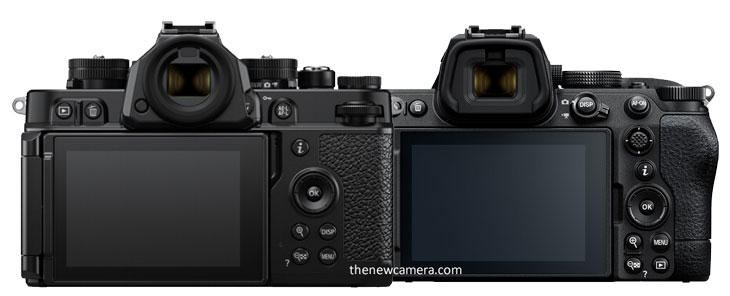
The Nikon Zf camera doesn’t have the joystick controller as we have in the Nikon Z5 II camera, it helps to navigate easily.
Internal core specifications of both the cameras.
Internally, both of the cameras are almost the same, so let’s start with the sensor.
Image sensor and image processor (same in both): Both cameras use a 24-megapixel BSI full-frame CMOS sensor. The Z5 II camera is paired up with the EXPEED 7 image processor. So technically, we will not find any big difference in the image quality performance of both the cameras. Both will provide us with similar types of images.
Image stabilization (same in both): Both of them feature a similar type of sensor-shift image stabilization unit inside them, and even the image processor that handles the firmware and the operation of the IBIS unit is the same. So the differences we see in the table—that one has 7.5 stops and the other has 8—may be due to some of the parameters that CIPA regularly changes while testing out the cameras. Although the IBIS unit inside both of these bodies is the same. And in both the cameras, we have an IS mechanism that you can link with lens VR (IBIS).
Continuous shooting speed (same in both): The Zf and Nikon Z5 II both can shoot at up to 11fps in RAW (in Continuous High Extended mode), and up to 15 or 14fps with the help of mechanical shutter, depending on the use of electronic or mechanical shutter for JPEG mode. There’s also a JPEG-only ‘C15’ and ‘C30’ mode that uses a video stream to shoot 30fps images. We also get a pre-burst option like that on the Z8 and Z9, in both the Nikon Z5 II and Nikon Zf.
Here’s a comparison table based on the information you provided for the Nikon Z5 II vs Nikon Zf:
| Feature |
Nikon Z5 II |
Nikon Zf |
| Design |
Modern DSLR-style with Standard controls |
Retro-style, Extensive manual controls |
| Build Quality |
Solid, ergonomic |
Built like a tank with vintage aesthetics |
| Handgrip Style |
Deep hand grip |
Lacks deep grip (requires external grip) |
| Memory Card Slots |
Dual card slots: 2x UHS-II SD |
Dual card slots: 1x UHS-II SD, 1x microSD |
| Electronic Viewfinder |
3.69 M-dot EVF, 3000 nits brightness |
3.69M-dot EVF |
| Sensor Type |
24MP BSI full-frame CMOS |
24MP BSI full-frame CMOS |
| Image Processor |
EXPEED 7 |
EXPEED 7 |
| Image Quality |
Similar performance |
Similar performance |
| Image Stabilization (IBIS) |
Yes (same unit as Zf) |
Yes (same unit as Z5 II), rated slightly higher (may vary due to CIPA testing) |
| Pixel Shift Mode |
Yes, 96 MP |
Yes, 96 Mp |
| IS + VR Sync |
Yes |
Yes |
| Continuous Shooting (RAW) |
Up to 11 fps (Continuous High Extended) |
Up to 11 fps (Continuous High Extended) |
| Pre-Shooting Buffer |
Yes |
No |
| JPEG Burst Modes |
C15 / C30 (up to 30fps JPEG via video stream) |
C15 / C30 (up to 30fps JPEG via video stream) |
| Pre-Burst Option |
Yes (like Z8/Z9) |
Yes (like Z8/Z9) |
| Battery Life & Ports |
Approx. same as Zf |
Approx. same as Z5 II |
Both cameras are capable of recording 4K videos at 60 fps with DX crop, and 4K 30 FPS oversampled video, as well as full HD videos up to 120 frames per second. All these frame rates are the same.
In a recent update to the firmware, the Nikon ZF received Clear Zoom as well as the latest Bird Eye Autofocus update.
Both of the cameras, the Nikon Z5 II and the Nikon ZF, record 4:2:2 10-bit videos internally in their SD card. Both of them share the 10-bit H.265, SDR, and N-Log modes as well as Red LUT LED support.
Now, where does the difference exist?
- The difference is that the Nikon Z5 II can record N-RAW videos internally in its SD card, whereas the Nikon ZF is limited to recording N-Log, unprocessed video, still not available in the ZF camera.
- Product Showcase mode: This exclusive feature is currently only limited to the Nikon Z5 II camera. We hope and expect that in upcoming firmware updates, Nikon ZF will get that, too.
| Feature |
Nikon Zf |
Nikon Z5 II |
| Max Video Resolution |
4K 60p (1.5x crop) |
4K 60p (1.5x crop) |
| Uncropped 4K |
Up to 30p |
Up to 30p |
| Full-HD Slow Motion |
Up to 120p |
Up to 120p |
| N-Log |
Yes, 10-bit |
Yes, 10-bit |
10-bit H.265 in SDR/HLG/N-log tone modes (both cameras)
|
| Waveform Monitor |
Yes |
Yes |
| RED LUTs Compatibility |
Yes |
Yes |
| N-Raw Recording |
Yes (12 Bit), internally |
No |
IBIS
|
Yes |
Yes |
| Electronic VR |
Yes |
Yes |
| Product Review Mode |
Yes |
No |
| High-Res Zoom |
Yes (2X) |
Yes (2X) |
The Conclusion
When we talk about photography performance, then both the camera Nikon Z5 II and Nikon ZF deliver almost the same performance the fact both of them feature the same sensor and image processor, and even the same sensor. Now, for photographers who love retro design, retro aesthetic, and extensive manual control over their body, they should prefer the Nikon ZF camera, but do remember that because the hand grip is minimal, you have to buy an additional hand grip for extended shoots. On the other side, we have the Nikon Z5 II, which features a very good DSLR-style modern design and deep hand grip — a perfect camera for weddings or even shooting.
Now, when we talk about videography, the Nikon Z5 II takes a slight lead, or you can say advantage, due to the availability of N-RAW recording which is not present inside the Nikon ZF camera. It will give professionals and videographers a bit more flexibility in colour grading and post-production. The other advantage that we have for content creators is the product showcase mode in Z52, so it’s an ideal camera for YouTube and content creators by enabling product showcase mode.
Nikon Zf vs Nikon Z5 II – Price Check – Latest Deals
Nikon Zf body price – B&H Store – Amazon.com
Get the Nikon Z5 II camera from B&H Store | Adorama.com | Amazon.com
Support us – Use or affiliate link Amazon.com | B&H Store | Adorama.com for the next purchase u make – it helps us 🙂
Follow us on our social pages FACEBOOK | TWITTER | INSTAGRAM to get live Camera News + Nikon Rumors 24X7
|
KEEP THIS BLOG ALIVE - Support New Camera Buy Canon Lenses, Buy Music CD or Digital Camera at amazon it helps this site, and you do not pay anything extra, it is just a way to help support this site.

|


















